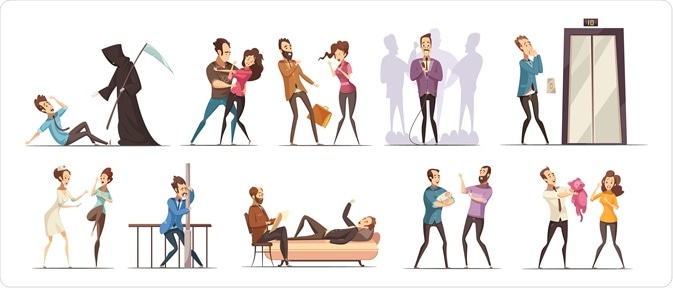Phobias are abnormal fear of a specific object, animal, bird, insect, activity, or a certain situation. It is a type of anxiety disorder that can precipitate a panic attack.
 Image Credit: Macrovector / Shutterstock.com
Image Credit: Macrovector / Shutterstock.com
Those with phobias tend to avoid the feared object or activity as much as possible and become anxious when they anticipate having to confront them.
These may be fears of an animal that they may well avoid in daily life, for example, the snake.
However, in some, the fears may be of more common objects and situations like fear of flying, interacting with people (social phobias), or using a closed lift (claustrophobia). This may severely hamper a person’s day to day life.
Mild phobias are widespread, particularly in childhood, although most of these fears disappear by the age of six or eight. People can also develop phobias when going through a particularly stressful period of their lives.
Research shows that approximately five percent of adults develop agoraphobia (fear of open spaces), and around one percent of the population develop severe debility due to this phobia.
Agoraphobia usually starts when a person is in their late 20s and is more common in women than men. Around one to two percent of men and women develop social phobia.
To be classed as a phobia, the symptoms must be due to anxiety and not arise from another physical or psychological problem.
Classification of phobias
Phobias may be grouped into two broad classes:
Simple / specific phobias
Simple or specific phobias like those of an object, animal, or situation. Specific phobias include fear of:
- Spiders
- Snakes
- Dogs
- Thunder
- Closed spaces
- Flying etc.
Simple phobias may also be a fear of blood, medical interventions such as injections, or injury. Sufferers may faint in the presence of blood or injury, following a reduction in their heart rate and blood pressure.
This is called a vasovagal response, which leads to fainting. It does not normally occur with other anxiety disorders. In other phobias and panic disorders, the person’s heartbeat and blood pressure usually increase as their arousal rate increases.
Complex phobias
Examples of complex phobias are social and agoraphobias. Social phobias are fears of interacting with people or social gatherings, and agoraphobias fear open spaces or public places where escape is difficult like shopping malls, public transport buildings, etc.
Agoraphobia is commonly associated with depression and marital or family disharmony. Both social and agoraphobia may lead to confinement of the patient within their homes.
 Image Credit: MonoLiza / Shutterstock.com
Image Credit: MonoLiza / Shutterstock.com
Common phobias
The most common phobias include fear of:
-
Spiders (Arachnophobia)
-
Social situations (social phobia)
-
Flying (Aviatophobia)
-
Open spaces (Agoraphobia)
-
Confined spaces (Claustrophobia)
-
Heights (Acrophobia)
-
Cancer (Cancerophobia)
-
Thunderstorms (fear of lightening – Astraphobia; fear of thunder – Brontophobia)
-
Death (Necrophobia)
-
Heart disease (Cardiophobia)
Less common phobias
Other less common phobias are fears of:
-
Needles/sharp objects (Aichmophobia)
-
Cats (Ailurophobia)
-
People (Anthropophobia)
-
Men (Androphobia)
-
Sex (Genophobia)
-
Women (Gynophobia)
-
Water (Aquaphobia)
-
Bees (Apiphobia)
-
Toads (Bufonophobia)
-
Dogs (Cynophobia)
-
Dentists and doctors (Dentophobia and Iatrophobia respectively)
-
Reptiles (Herpetophobia)
-
Sleep (Hypnophobia)
-
Mice (Musophobia)
-
Dirt and germs (Mysophobia)
-
Anything new (Neophobia)
-
Night (Noctiphobia)
-
Darkness (Nyctophobia)
-
Snakes (Ophidiphobia)
-
Fire (Pyrophobia)
-
Being buried alive (Taphophobia)
-
God (Theophobia)
-
Strangers (Xenophobia)
-
Animals (Zoophobia)
References
Further Reading
Last Updated: Feb 17, 2023